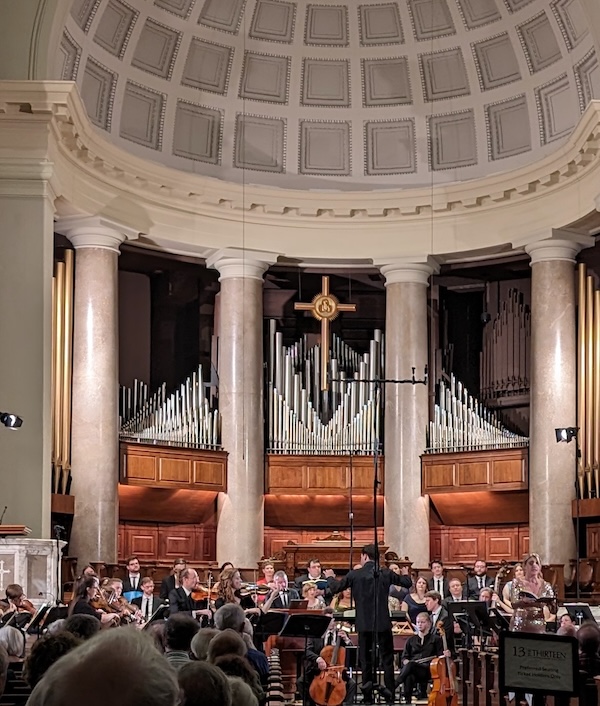The Thirteen’s breathless Mass in B minor achieves belated depth and resonance

The Thirteen performed Bach’s Mass in B minor Sunday at National City Christian Church. Photo: WCR
Among J.S. Bach’s greatest achievements, the Mass in B minor comes second only to the St. Matthew Passion, largely because the latter, unlike the former, was composed as a unified work. Matthew Robertson led his chamber choir The Thirteen in a grand interpretation of the Mass Sunday night. For this performance, the second of two at National City Christian Church, the choir partnered with an accomplished orchestra of historic-instrument specialists.
Bach, a Lutheran, initially limited himself to the shorter form of the Latin Ordinary used in that church, with only the Kyrie and Gloria. Beginning in 1724, three hundred years ago this year, he had composed a Sanctus in six voices, beginning the piecing together of what would become the “great Catholic Mass” he finally completed in 1749, a year before he died. Even though many parts were repurposed from earlier music, the combined result makes a convincing and monumental whole.
On one hand, Robertson’s interpretation was conventional. Soloists sang only those pieces explicitly labeled as arias in the score. Some scholars believe that Bach intended his choral works, including the B Minor Mass, as something like a vocal concerto, featuring an alternation of the full choir and soloists singing one on a part. Others, like Joshua Rifkin, believed everything was sung one on a part. Robertson’s full choir sang all the choral parts, which range from four to eight voices, with all singers contributing.
The resulting lack of textural variety can become monotonous and also places stress on the singers, who have to sing not only all the choral music, but the arias and ensembles. Robertson compensated with some extreme tempos. For example, in the first Kyrie, after a glacially paced introductory section, which bears no tempo marking, the subsequent contrapuntal section sped along much more quickly than its indication of Largo seems to imply.
The twenty-three singers caught most of the notes, even at these lightning speeds, but in the fastest sections, like the “Cum Sancto Spiritu” at the end of the Gloria, rapidly moving notes became a jumbled blur. The temptation is great, for a conductor working with a bevy of top-notch vocalists like this, to show his singers’ skills off like a race-car driver in a high-performance vehicle. The rashness, however, undermined the music at times like these.
All was forgiven in the second half when Robertson got to the two movements at the center of the cruciform structure of the Credo. The reverent stillness of the “Et incarnatus section” impressed, with limpid treble sound rising up over the slow ostinato of the instruments. This music, which can seem to stop time when performed like this, came from the very end of the compositional process of the Mass and may be Bach’s last significant completed composition.
The true center of the Credo, the fifth of the nine movements, is the “Crucifixus,” adapted by Bach from his Cantata No. 12 (“Weinen, klagen, sorgen, sagen”). Again at a deliberate tempo, Robertson helped his singers shape their lines, with the clashing suspensions of the music almost like auditory, slow-motion markers of the suffering of Jesus on the cross. At the end of this movement, set to the words about Jesus being placed in the tomb, Robertson enhanced the decrescendo effect in Bach’s score by having the instruments drop out completely, leaving just the very soft, unaccompanied voices.
The solo contributions were all strong, with some standing out more than others, like the intense low vocalism of mezzo-soprano Aryssa Leigh Burns in the duet “Christe eleison.” Kudos to soprano Tiana Sorenson, who stepped in for an ailing colleague, for saving the “Domino Deus” duet with laser-focused tenor Oliver Mercer. Soprano Chelsea Helm and mezzo Rhianna Cockrell soared on the twinned parts in “Et in unum dominum” in the Credo.
In some cases, instrumental obbligatos outshone their vocal colleagues, most notably in the outstanding natural horn solo by Brad Tatum in “Quoniam tu solus sanctus” with bass-baritone Steven Hrycelak. Likewise, the two oboists, Meg Owens and Fatma Daglar, had a charming moment in the sun on the oboe d’amore parts in “Et in spiritum sanctum” with baritone Edward Vogel. Lead bassoonist Anna Marsh, besides her laudable bassoon work all evening, also took the third oboe part required only in the Sanctus movement.
The two strongest vocal soloists came toward the end of the evening. Tenor Gene Stenger’s pliant but focused upper range suited the “Benedictus” perfectly, matched by the strongest playing of the evening from flutist Leighann Daihl Ragusa, recovering from some struggles in the first half. Mezzo-soprano Kate Jackman plied her rich, burning tone to the “Agnus Dei.”
After pushing so many tempi nearly to the breaking point throughout the evening, Robertson made a clear distinction of character in the “Dona nobis pacem” that concluded the Mass, after over a hundred minutes of music. The music is almost identical to the “Gratias agimus tibi” section of the Gloria, but where that initial rendition had been a little harried, Robertson slowed down the pacing the second time around, building a convincing climax through a gradual amassing of sound, with timpani and three trumpets crowning the night in regal splendor.
The Thirteen performs Poulenc’s Figure Humaine, complemented by recent works of Hilary Purrington, including a world premiere) and Jeffrey Van, May 17 to 19. thethirteenchoir.org
